
Extinct Australian animals
Encyclopedia
Following a complete list of Australian animal extinctions from 1788
to the present. There are 23 birds, 4 frogs, and 27 mammal species or subspecies strongly believed to have become extinct since European settlement of Australia.
Extinctions are recorded under the Environment Protection and Biodiversity Conservation Act 1999
.
Several invertebrate species have also been listed as extinct by the World Conservation Union (IUCN), however this list is less exhaustive, as invertebrates are more difficult to survey and are less well studied.
as having become extinct. However they are not listed as extinct under Australian legislation.
First Fleet
The First Fleet is the name given to the eleven ships which sailed from Great Britain on 13 May 1787 with about 1,487 people, including 778 convicts , to establish the first European colony in Australia, in the region which Captain Cook had named New South Wales. The fleet was led by Captain ...
to the present. There are 23 birds, 4 frogs, and 27 mammal species or subspecies strongly believed to have become extinct since European settlement of Australia.
Extinctions are recorded under the Environment Protection and Biodiversity Conservation Act 1999
Environment Protection and Biodiversity Conservation Act 1999
The Environment Protection and Biodiversity Conservation Act 1999 is an Act of the Parliament of Australia that provides a framework for protection of the Australian environment, including its biodiversity and its natural and culturally significant places...
.
Several invertebrate species have also been listed as extinct by the World Conservation Union (IUCN), however this list is less exhaustive, as invertebrates are more difficult to survey and are less well studied.
Birds
| Species | Common Name | Location(s) | Comments | Pictures |
| Aplonis fusca | Norfolk Starling | Norfolk Island, NSW | 1923. Competition from introduced European Starling, Song Thrush and Common Blackbird, clearance for agriculture. | |
| Columba vitiensis godmanae | White-throated Pigeon (Lord Howe Island), Lord Howe Pigeon | Lord Howe Island |  |
|
| Cyanoramphus erythrotis | Red-crowned Parakeet (Macquarie Island), Macquarie Island Parakeet | Macquarie Island | ||
| Cyanoramphus novaezelandiae subflavescens | Red-crowned Parakeet (Lord Howe Island), Lord Howe Parakeet | Lord Howe Island | ||
| Dasyornis broadbenti litoralis Rufous Bristlebird The Rufous Bristlebird is a species of bird in the Dasyornithidae family.It is endemic to Australia.Its natural habitat is temperate forests.It is threatened by habitat loss.-Australia:... |
Rufous Bristlebird (western), South-western Rufous Bristlebird | WA | ||
| Dromaius ater | Dwarf Emu, King Island Emu | TAS | 1822. Extinction through hunting and, apparently, fires started by visiting sailors | |
| Dromaius baudinianus | Kangaroo Island Emu | Kangaroo Island | 1805. Extinction has been attributed to hunting and habitat clearance through burning. A captive bird died in 1822 |  |
| Dromaius novaehollandiae diemenensis | Emu (Tasmanian) | TAS | 1850 | |
| Drymodes superciliaris colcloughi | Roper River Scrub-robin | NT | This subspecies maybe invalid. It is known from only 2 specimens of doubtful provenance. | |
| Gerygone insularis | Lord Howe Gerygone, Lord Howe Warbler | Lord Howe Island | ||
| Hemiphaga novaeseelandiae spadicea | New Zealand Pigeon (Norfolk Island race) | Norfolk Island | 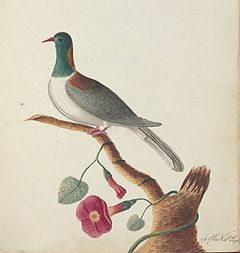 |
|
| Lalage leucopyga leucopyga | Norfolk Island Long-tailed Triller | Norfolk Island | ||
| Nestor productus | Norfolk Island Kaka | Norfolk Island | 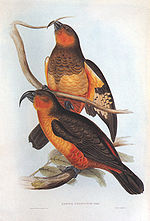 |
|
| Ninox novaeseelandiae albaria | Southern Boobook (Lord Howe Island), Lord Howe Boobook Owl | Lord Howe Island | ||
| Ninox novaeseelandiae undulata | Southern Boobook (Norfolk Island), Norfolk Island Boobook Norfolk Island Boobook The Norfolk Boobook , also known as the Norfolk Island Boobook, Norfolk Island Owl or Norfolk Island Morepork, was a bird in the true owl family endemic to Norfolk Island, an Australian territory in the Tasman Sea between Australia and New Zealand. It is an extinct subspecies of the Southern Boobook... |
Norfolk Island | 1996 | |
| Porphyrio albus | White Gallinule | Lord Howe Island | 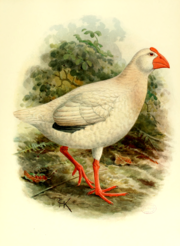 |
|
| Psephotus pulcherrimus | Paradise Parrot | NSW, QLD | Date uncertain but around 1927; more recent sightings are sometimes claimed but have never been confirmed. Cause uncertain, most hypotheses centre on starvation from lack of grass seed after drought, overgrazing, more frequent fires, and introduction of prickly pear Prickly pears in Australia Prickly pears are an invasive plant species in Australia.Prickly pears were imported into Australia in the 19th century for use as a natural agricultural fence and in an attempt to establish a cochineal dye industry. They quickly became a widespread invasive species, rendering of farming land... . |
|
| Rallus pectoralis clelandi | Lewin's Water Rail (western) | WA | ||
| Gallirallus philippensis macquariensis | Macquarie Island Rail | Macquarie Island | ||
| Rhipidura cervina | Lord Howe Fantail | Lord Howe Island | ||
| Turdus poliocephalus poliocephalus | Norfolk Island Thrush, Grey-headed Blackbird | Norfolk Island | 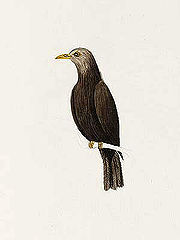 |
|
| Turdus poliocephalus vinitinctus | Lord Howe Island Thrush | Lord Howe Island | ||
| Zosterops albogularis | White-chested White-eye, Norfolk Island Silvereye | Norfolk Island | The IUCN considers this species endangered; it is listed as extinct under the EPBC act since it has not been officially documented for over 20 years. | |
| Zosterops strenuus | Robust White-eye | Lord Howe Island | Early 1920s. Predation by Rattus rattus |
Amphibians
The reason for the decline and extinction of these frog species is unclear, decline in frog populations is an international phenomenon.| Species | Common Name | Location(s) | Comments | Pictures |
| Rheobatrachus silus | Gastric-brooding Frog | QLD | Last wild specimen recorded in 1981 | |
| Rheobatrachus vitellinus | Eungella Gastric-brooding Frog | QLD | Last wild specimen recorded in 1985 | |
| Taudactylus acutirostris | Sharp-snouted Day Frog, Sharp-snouted Torrent Frog | QLD | Last wild specimen recorded in 1997 | |
| Taudactylus diurnus | Southern Day Frog, Mt Glorious Torrent Frog | QLD | Last wild specimen recorded in 1979 |
Reptiles
| Species | Common Name | Location(s) | Comments |
| Varanus loi | Norfolk Island Monitor lizard | Norfolk Islands |
Mammals
| Species | Common Name | Location(s) | Comments | Pictures |
| Bettongia gaimardi gaimardi | Eastern Bettong (mainland) | NSW, QLD, SA, VIC | ||
| Bettongia lesueur graii | Boodie, Burrowing Bettong Bettong The bettongs are species of the genus Bettongia, sometimes referred to as rat-kangaroos. Five species are recognised:* Eastern Bettong, Bettongia gaimardi* Boodie, Bettongia lesueur... (inland) |
WA | ||
| Bettongia penicillata penicillata | Brush-tailed Bettong (south-east mainland) | NSW, NT, SA, VIC, WA | ||
| Caloprymnus campestris | Desert Rat-kangaroo | QLD, SA | 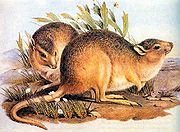 |
|
| Chaeropus ecaudatus | Pig-footed Bandicoot Bandicoot Bandicoots are a group of about 20 species of small to medium-sized, terrestrial marsupial omnivores in the order Peramelemorphia.- Etymology :... |
NSW, NT, SA, VIC, WA | 1950s |  |
| Conilurus albipes | White-footed Rabbit-rat White-footed rabbit-rat The White-footed Rabbit-rat is an extinct species of rodent, which was originally found in woodlands from Adelaide to Sydney, but became restricted to south-eastern Australia. It was kitten-sized and was one of Australia's largest native rodents. It was nocturnal and lived among trees... |
NSW, QLD, SA, VIC | 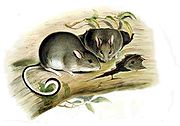 |
|
| Lagorchestes asomatus | Central Hare-wallaby | NT | 1935 | |
| Lagorchestes hirsutus hirsutus | Rufous Hare-wallaby (south-west mainland) | NT, SA, WA | 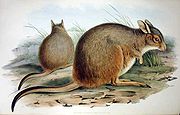 |
|
| Lagorchestes leporides | Eastern Hare-wallaby | NSW, QLD, SA, VIC | 1890 | 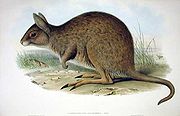 |
| Lagostrophus fasciatus albipilis | Banded Hare-wallaby (mainland) | WA | ||
| Leporillus apicalis | Lesser Stick-nest Rat | NSW, NT, SA, VIC, WA | 1933 | 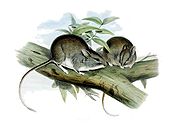 |
| Macropus eugenii eugenii | Tammar Wallaby (South Australia) | SA | Population Rediscovered in New Zealand New Zealand New Zealand is an island country in the south-western Pacific Ocean comprising two main landmasses and numerous smaller islands. The country is situated some east of Australia across the Tasman Sea, and roughly south of the Pacific island nations of New Caledonia, Fiji, and Tonga... |
 |
| Macropus greyi | Toolache Wallaby | SA, VIC | 1932 | |
| Macrotis leucura | Lesser Bilby | NT, QLD, SA | 1931 | 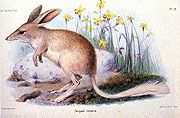 |
| Notomys amplus | Short-tailed Hopping-mouse | NT, SA | 1896 | |
| Notomys longicaudatus | Long-tailed Hopping-mouse | NT, SA, WA | ||
| Notomys macrotis | Big-eared Hopping-mouse | WA | 1843 | |
| Notomys mordax | Darling Downs Hopping-mouse | NSW, QLD | 1846 | |
| Nyctophilus howensis | Lord Howe Long-eared Bat | Lord Howe Island | ||
| Onychogalea lunata | Crescent Nail-tail Wallaby | SA, WA | 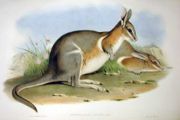 |
|
| Perameles bougainville fasciata | Western Barred Bandicoot (mainland) | NSW, VIC | ||
| Perameles eremiana | Desert Bandicoot | NT, SA, WA | ||
| Potorous platyops | Broad-faced Potoroo Broad-faced Potoroo The Broad-faced Potoroo is an extinct species of marsupial that once lived in Australia. The first specimen was collected in 1839 and described by John Gould in 1844, but even then it was rare and only a handful of specimens were ever collected, the last in 1875... |
WA | 1865 | 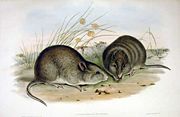 |
| Pseudomys gouldii | Gould's Mouse | NSW, QLD, SA, VIC, WA | 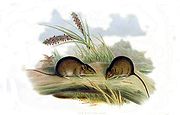 |
|
| Rattus macleari | Maclear's Rat | Christmas Island | 1908 | |
| Rattus nativitatis | Bulldog Rat | Christmas Island | last recorded in 1903 | |
| Thylacinus cynocephalus | Thylacine Thylacine The thylacine or ,also ;binomial name: Thylacinus cynocephalus, Greek for "dog-headed pouched one") was the largest known carnivorous marsupial of modern times. It is commonly known as the Tasmanian tiger or the Tasmanian wolf... , Tasmanian Tiger |
TAS | 1936 There have been 4-10 sightings a year but not confirmed. |
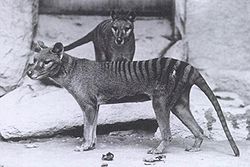 |
Invertebrates
Several Australian Invertebrates have been listed by the World Conservation UnionWorld Conservation Union
The International Union for Conservation of Nature and Natural Resources is an international organization dedicated to finding "pragmatic solutions to our most pressing environment and development challenges." The organization publishes the IUCN Red List, compiling information from a network of...
as having become extinct. However they are not listed as extinct under Australian legislation.
| Species | Common Name | Location(s) | Comments | Pictures |
| Hypolimnus pedderensis | Lake Pedder Earthworm | TAS | Probably extinct in 1972, confirmed in 1996 | |
| Romankenkius pedderensis | Lake Pedder Planarian | TAS | Probably extinct in 1972, confirmed in 1986 http://www.iucnredlist.org/search/details.php/19741/all | |
| Tornelasmias capricorni Tornelasmias capricorni Tornelasmias capricorni was a species of gastropod in the Achatinellidae family. It was endemic to Australia.-References:* Ponder, W.F. 1996. . Downloaded on 7 August 2007.... |
http://www.iucnredlist.org/search/details.php/21996/all | |||
| Austrogammarus australis Austrogammarus australis Austrogammarus australis, also known as the "Dandenong amphipod" is a species of amphipod crustacean in family Paramelitidae. It is endemic to Australia and until recently thought to be extinct, but surveys conducted in the Dandenong Ranges have revealed small populations... |
Rediscovered. Status requires updating http://www.iucnredlist.org/search/details.php/2425/all | |||
| Beddomeia tumida Beddomeia tumida †Beddomeia tumida was a species of very small freshwater snail that has a gill and an operculum, an aquatic operculate gastropod mollusk in the family Hydrobiidae. This species was endemic to Australia but is now extinct.-References:... |
1996 http://www.iucnredlist.org/search/details.php/2713/all | |||
| Angrobia dulvertonensis Angrobia dulvertonensis †Angrobia dulvertonensis was a species of minute freshwater snail with an operculum, an aquatic gastropod mollusk or micromollusk in the family Hydrobiidae. This species was endemic to Australia.... |
1996 http://www.iucnredlist.org/search/details.php/1292/all | |||
| Placostylus bivaricosus etheridgei | http://www.iucnredlist.org/search/details.php/17448/all |

